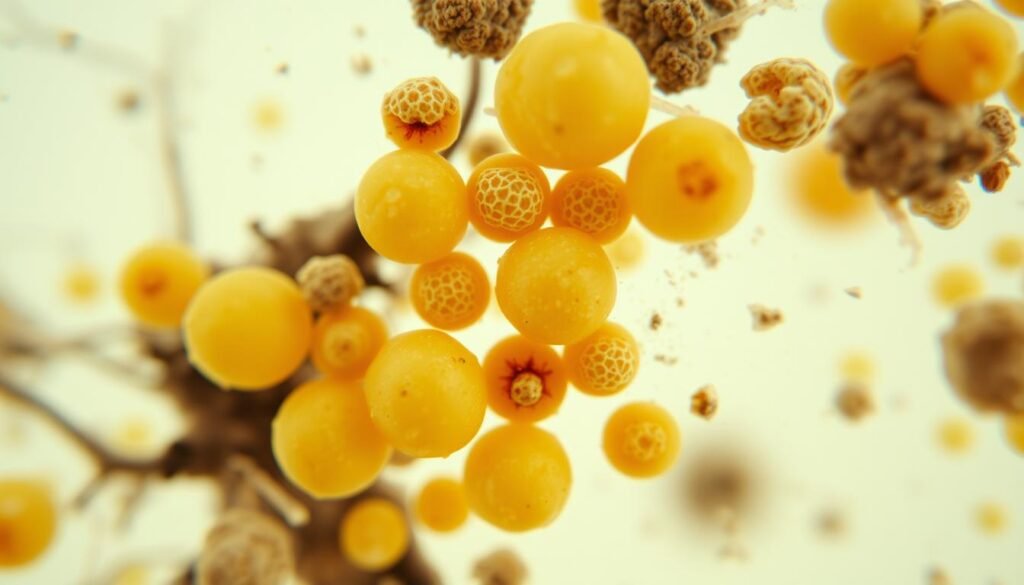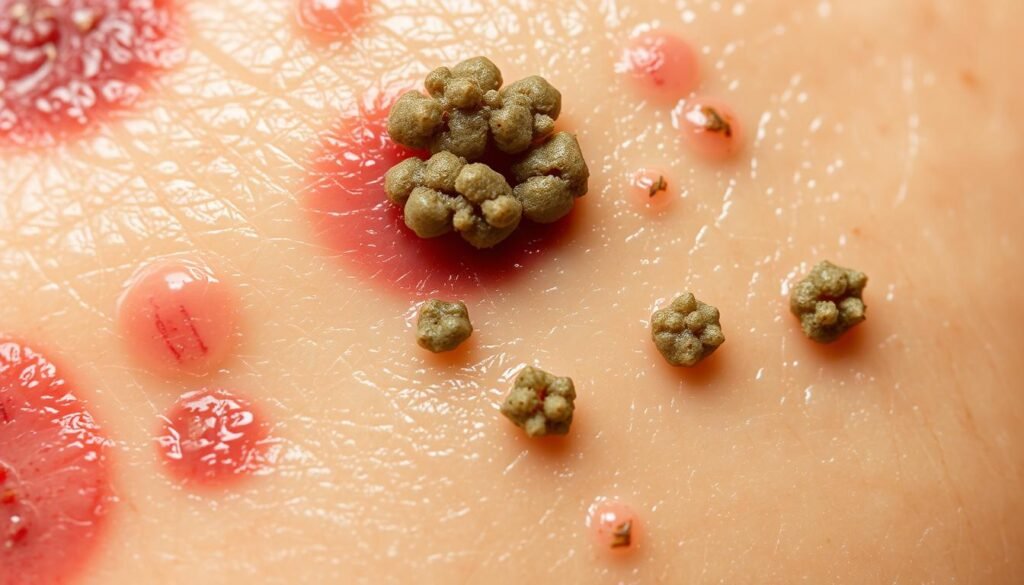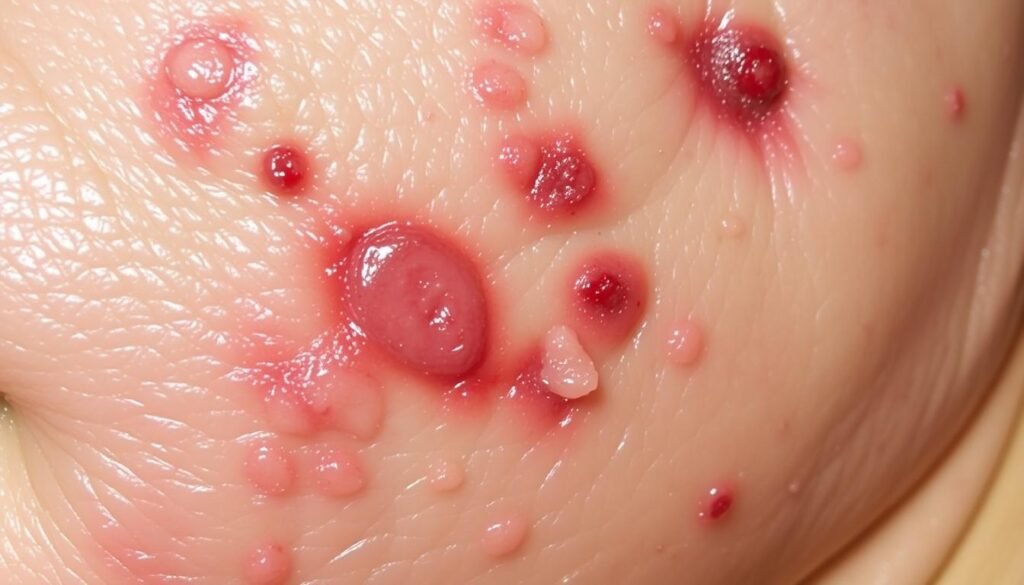Did you know up to 350 million adults worldwide suffer from seborrheic dermatitis? This is often due to the Malassezia fungus. It shows how common and serious oily skin and fungal issues are. In this guide, we’ll explain how too much oil and Malassezia can harm your scalp and skin.
This guide will help you understand the skin microbiome’s role in skin health. Knowing about Malassezia yeasts is the first step in tackling their effects on the skin. We will look at how to diagnose and treat these conditions for healthier skin.
Key Takeaways
- Malassezia fungi love oily skin, causing many skin problems.
- Fungal acne looks a lot like regular acne but needs different treatments.
- To treat skin right, telling fungal and bacterial issues apart is key.
- Preventing Malassezia growth starts with good skin care routines.
- Knowing your skin can better fight oiliness and fungal issues.
Understanding Oiliness in Skin
Oily skin comes from different things that increase sebum production. Knowing these factors helps in controlling oiliness and keeping the skin healthy. Oily skin is often due to hormonal changes, genes, what you eat, and where you live.
Knowing how these things work together can help people take better care of their skin.
What Causes Sebum Production?
Hormones have a big part in controlling sebum. For example, during puberty or with hormone medicines like birth control, oil production can go up. Genetics also play a role in how oily our skin gets. Some people have more oil due to their family history.
Places with high humidity can make oily skin worse. When it’s very humid, the air holds on to moisture, making hair and skin feel greasy. Stress can raise hormone levels too, causing the skin to become oilier.
Impact of Oily Skin on Overall Skin Health
Oily skin is not just a surface issue; it impacts skin health deeply. Too much oil can damage the skin barrier. This leads to irritation and more acne. Conditions like seborrheic dermatitis are linked to oily skin and Malassezia fungus thriving on sebum.
The link between sebum and the skin’s microbiome is key to skin health. An unbalanced microbiome can cause issues like too much Malassezia. This shows why managing oily skin is important for skin health.
| Factors Affecting Sebum Production | Examples | Potential Impact |
|---|---|---|
| Hormonal Fluctuations | Puberty, Birth Control Medications | Increased Oil Output |
| Genetic Predisposition | Family History of Oily Skin | Higher Likelihood of Oiliness |
| Environmental Conditions | High Humidity | Difficulty in Moisture Evaporation |
| Psychological Factors | Stress | Enhanced Sebum Production |
What is Malassezia Fungus?
Malassezia fungus is a group of yeasts found on our skin. They’re usually harmless and part of the skin’s natural community. But if they grow too much, they can cause skin infections. It’s essential to know about Malassezia to understand when it might cause problems.
Characteristics of Malassezia Yeast
The genus Malassezia has 14 known species, including M. furfur and M. globosa. These species are linked to some skin issues. They love skin oils and grow well in oily areas.
For over 150 years, studies have shown Malassezia yeasts are part of our skin and can also lead to diseases. The list of Malassezia species has grown as we learn more about their DNA. Species like M. sympodialis and M. restricta are found worldwide, each adapted to specific parts of the skin.
Scientists can spot these yeasts by their unique budding under the microscope. Yet, to tell the species apart, more advanced DNA methods are needed. These methods are more accurate than older ones. The adaptability of Malassezia shows they play various roles, both good and bad, on our skin.

Oiliness and Malassezia Fungus: The Connection
Understanding how oily skin connects to Malassezia fungus growth is key. Too much oil makes a welcoming place for this fungus, especially Malassezia spp., to grow. This yeast loves oily skin areas and can cause different skin problems. Knowing how they link can help in boosting skin health.
How Excess Sebum Fuels Fungal Overgrowth
Oily skin is like a paradise for Malassezia yeast. More oil means more chances for this fungus to grow. Where there’s a lot of oil, Malassezia isn’t far behind. This leads to issues like seborrheic dermatitis and tinea versicolor, more so where it’s moist. Between 1 and 5 percent of people get seborrheic dermatitis, showing it’s a common oily skin issue. Curious minds can dive deeper into these facts through specific studies.
Identifying Symptoms of Malassezia Overgrowth
Spotting signs of Malassezia overgrowth early can help in treating it. Look out for itchy red bumps, peeling, and flaky skin. These symptoms can make someone feel bad about how they look. Men report these issues more than women do. Knowing what to watch for means you can take action sooner. Dandruff’s impact extends to hair health too. Learn more about it in these resources.

Common Skin Conditions Associated with Malassezia
Many people suffer from skin problems caused by Malassezia. This shows why it’s key to know how it affects skin health. Two top issues from this fungus are seborrheic dermatitis and fungal acne.
Knowing what symptoms look like helps people find the right help. This way, they can take care of their skin properly.
Understanding Seborrheic Dermatitis
Seborrheic dermatitis often hits where skin is oilier. Places like the scalp, face, and chest. Here, you might see flaky patches, red skin, and dandruff that’s hard to get rid of.
This condition can come and go. Stress, weather changes, and certain health issues can make it worse. That’s why knowing what triggers it helps in controlling it.
- Commonly affected areas:
- Scalp
- Face
- Sides of the nose
- Eyebrows
- Ears and eyelids
- Chest
- Potential risk factors:
- Stress and fatigue
- Changes in season
- Nervous system conditions (e.g., Parkinson’s disease)
- Mental health conditions (e.g., depression)
- Immune system disorders (e.g., HIV infection)
Fungal Acne: Malassezia Folliculitis Explained
Malassezia folliculitis, or fungal acne, looks a lot like regular acne. It shows up as small, same-shaped bumps. But it’s actually caused by too much Malassezia yeast.
Unlike acne, oily skin helps this yeast grow. Doctors often treat it with antifungal meds. These treatments attack the source, easing the discomfort it brings.

| Condition | Symptoms | Treatment Options |
|---|---|---|
| Seborrheic Dermatitis | Scaly patches, inflamed skin, dandruff | Medicated shampoo, regular skincare |
| Malassezia Folliculitis | Monomorphic papules, itchy skin | Topical and oral antifungal medications |
Diagnosing Malassezia Infections
Getting the diagnosis right is key to treating Malassezia infections well. Doctors use various methods to pinpoint these issues. These conditions are often mistaken for other skin problems. Knowing the signs of fungal acne, for example, helps make sure patients get the right help.
Techniques for Accurate Diagnosis
Doctors follow several important steps to diagnose Malassezia infections:
- Looking at the skin to spot symptoms.
- Using a Wood’s lamp to highlight affected areas.
- Taking skin scrapings to see the yeast under a microscope.
- Doing a skin biopsy to confirm Malassezia if needed.
These methods are vital to tell fungal acne from other skin issues. Watch for itchy bump clusters on your face, upper back, or shoulders. They are usually similar in size and shape.
Common Misdiagnoses to Avoid
Mistaking fungal acne for something else can lead to wrong treatments. Some conditions that get confused with Malassezia infections are:
| Condition | Key Differences |
|---|---|
| Bacterial folliculitis | Caused by bacteria, shows as pus-filled bumps with redness. |
| Acne vulgaris | Marked by larger, swollen sores and blackheads. |
| Demodex folliculitis | Mites cause it, leading to pustular or papular outbreaks. |
Knowing these key differences helps in diagnosing Malassezia correctly. An incorrect diagnosis can extend discomfort and make treatment harder. This highlights the importance of accurately identifying symptoms of Malassezia infections.
Treatment Options for Malassezia-Related Conditions
Knowing how to treat Malassezia-related skin issues is key. There are many options, like anti-dandruff shampoo and antifungal treatments. Each helps soothe symptoms and make your skin healthy again.
Effective Use of Anti-Dandruff Shampoos
Anti-dandruff shampoos are very important for handling seborrheic dermatitis and Malassezia folliculitis. They have ketoconazole, zinc pyrithione, and selenium sulfide. These ingredients lower fungal levels on the scalp.
Ketoconazole can get rid of the fungus in 65% of cases. Shampoos with zinc pyrithione can completely cure fungal issues related to Malassezia.
Topical and Oral Antifungal Treatments
Topical antifungal creams like those with imidazole are popular. They’re used a lot and work directly against Malassezia. Medicines like clotrimazole and miconazole are common.
For tougher cases, doctors may prescribe oral antifungals. Itraconazole and fluconazole are good choices for stubborn infections. It’s also important to keep using medicine to stop the infection from coming back. This is especially true for conditions like pityriasis versicolor or seborrheic dermatitis.
| Treatment Type | Active Ingredients | Effectiveness |
|---|---|---|
| Anti-Dandruff Shampoo | Ketoconazole, Zinc Pyrithione | High (up to 100%) |
| Topical Antifungals | Clotrimazole, Miconazole | Moderate |
| Oral Antifungals | Fluconazole, Itraconazole | Variable |
Preventing Recurrence of Malassezia Overgrowth
Keeping Malassezia from growing too much is key for healthy skin. To do this, keeping your skin’s barrier strong and having a good daily skin care routine are important. Doing these things can lower the chance of skin problems and keep your skin healthy.
Maintaining Skin Barrier Function
Keeping your skin’s barrier healthy is crucial in stopping Malassezia. A strong barrier protects against things that can irritate your skin and harmful microbes. You should use products like moisturizers with ceramides and hyaluronic acid to keep moisture in. It’s also vital to avoid strong soaps that remove your skin’s natural oils.
Choosing mild cleaning options helps your skin stay healthy. This means it can fix itself and is less likely to have fungal overgrowth.
Daily Skin Care Practices to Consider
To fight Malassezia, a well-planned daily skin care routine is helpful. You should:
- Use products that don’t block pores.
- Pick ingredients with antifungal effects, like tea tree oil.
- Exfoliate with AHA or BHA once or twice a week to remove dead skin cells. This helps prevent blocked follicles.
- Apply moisturizer regularly to strengthen your skin’s defenses.
These steps help keep your skin’s barrier strong, stopping Malassezia from becoming a problem. To learn more about managing this, check out detailed studies on this topic.
The Role of Lifestyle in Managing Oiliness and Malassezia Fungus
Lifestyle factors greatly affect your skin’s oiliness and Malassezia fungus. Your diet and environment can change how much oil your skin makes. They also impact your skin’s health.
Dietary Choices that Impact Skin Health
Eating well helps keep your skin healthy. Omega-3 fatty acids may lower inflammation, aiding in conditions like seborrheic dermatitis. Foods to eat include:
- Fatty fish such as salmon and mackerel
- Chia seeds and flaxseeds
- Walnuts
- Leafy greens
Cutting out foods that feed yeast might also help with Malassezia skin problems. You should avoid:
- Bread
- Cheese
- Wine
- Beer
Making these dietary changes can help control oil production and keep your skin healthy.
Environmental Factors: Climate and Sebum Production
The environment, especially the climate, affects your skin. Cold, dry weather can make seborrheic dermatitis worse, making your skin oilier. On the other hand, high humidity might increase oiliness and encourage fungal growth.
Stress can also make skin conditions worse. Using mindfulness or therapy to manage stress can help your skin health too.
By choosing the right foods and being mindful of the climate, you can control skin oiliness. This helps fight against Malassezia fungus effectively.
Conclusion
The link between oiliness and Malassezia fungus is key for skin health. The oil our skin makes feeds the Malassezia fungus. This can cause skin problems like seborrheic dermatitis and fungal acne. It’s important to know how sebum and Malassezia work together.
To keep skin healthy, it’s critical to know what affects it. Keeping a healthy pH and sticking to a skincare routine helps. This can stop too much fungus from growing and keeps skin in top shape. Paying attention to oil and fungus helps make skin healthier.
Taking action early, making smarter lifestyle and diet choices, and following a good skincare routine are powerful steps. Knowing how oiliness and Malassezia fungus interact gives us the tools to keep our skin looking great. This awareness helps everyone have a better and more glowing complexion.